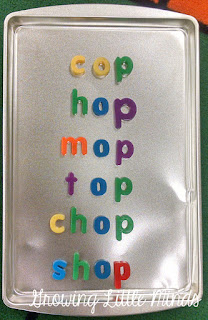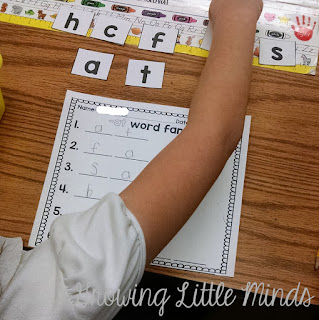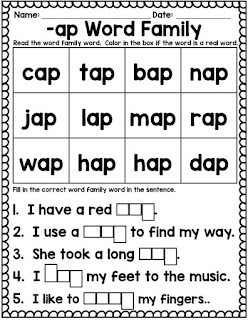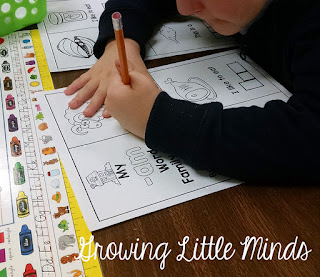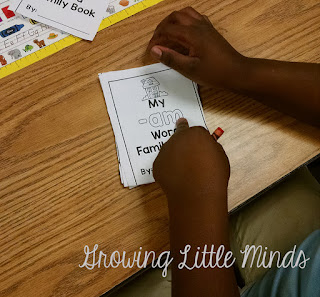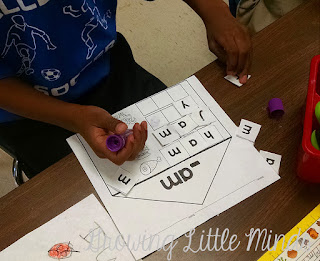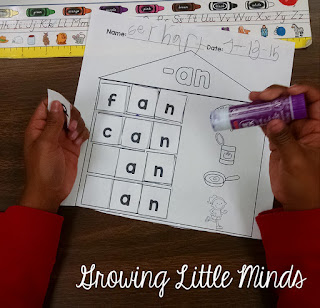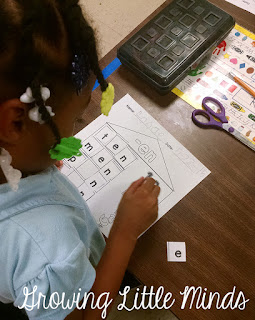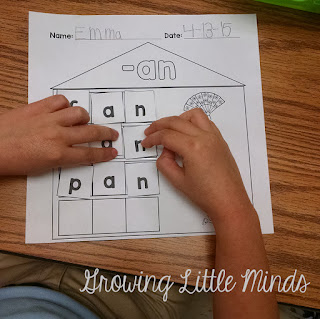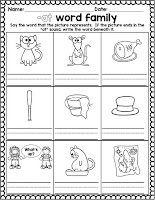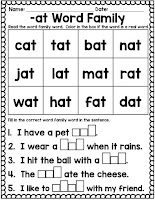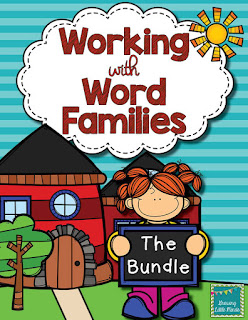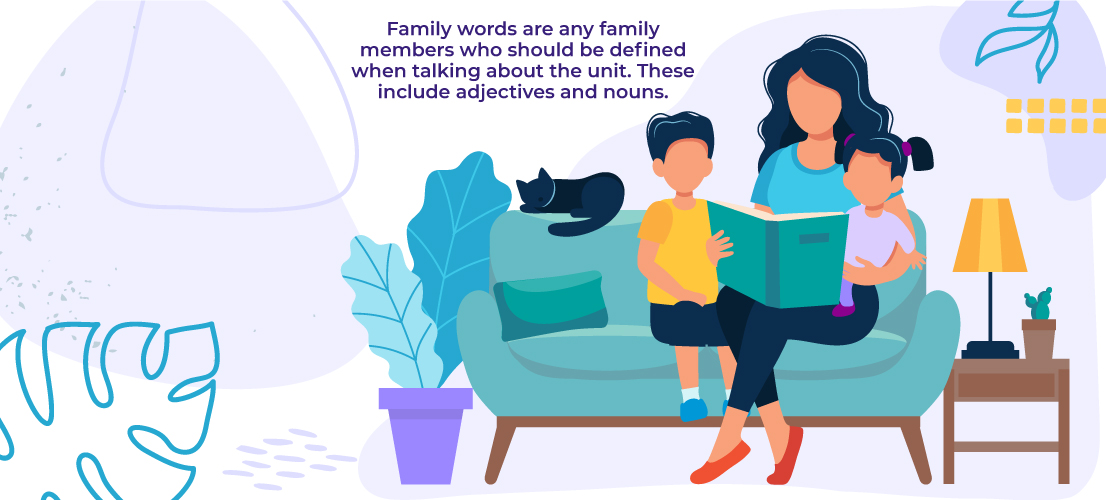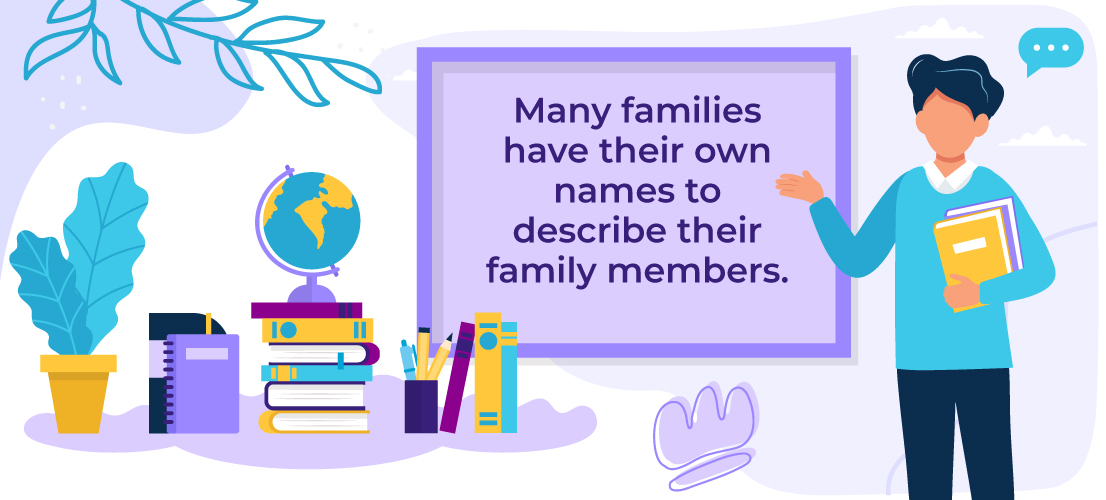A post about the importance of word families and how to teach reading with word families. Daily suggestions, ideas, and activities for teachers provided.

Today I am sharing about one part of my word study program, how to teach reading with word families. I will be sharing how I run my schedule during the week and provide you with a day-to-day plan of action. I have seen a lot of success with this program. My students are thoroughly engaged, actively learning, and building their reading and spelling skills.
Why Teach Word Families?
Learning to read the English language is a difficult task. The English language follows so many different patterns and rules that it is often confusing for our younger students learning to read.
Word families, also called phonograms or “chunks,” provide us with groups of words that have a predictable pattern or “chunk.” These words have the same ending, and they all rhyme. This makes learning a set of words (a word family) easier on our beginning readers.
Word Families Throughout the Week
After learning our word families for the week, my students can read and spell a group of words independently. They feel incredibly successful at their accomplishment. They now have a larger bank of words they can read in the books they are encountering.
Teaching my students word families is an incredibly efficient way for me to teach my students how to read. Since we learn word families each week, I wanted to create a set of activities that students find fun and engaging, yet help them to become fluent in reading the words within a word family.
Monday Activities for Teaching Word Families
Each week we focus on two-word families at a time. I start with teaching the short vowel word families and start with the short ‘a’ word families. The words within those word families often follow a CVC or CVCC pattern. They are simple words that children often know and understand.
I introduce our word families one at a time, and as a class, we brainstorm all the words we can think of that end with that sound pattern. Then, I encourage my students to use our alphabet posters above our whiteboard as a reference. I will say, “take each letter one at a time and put it in front of the letter pattern. Does it make a word that makes sense?” If it makes sense, I ask them to put up their hand and share with the class. I record the words they come up with on our word chart. We discuss the meaning of each word.
Some weeks I like to switch things up, and I will have my students line up and rotate one at a time or in pairs to write down a word that they have come up with. I will sit close by and help if needed.

After we have our list of new words on our chart, my students will copy those words in their word family books. They are practicing their handwriting skills and rereading their new words at this time.

I send our word family book home on Monday for families to practice at home all week.
Tuesday Activities for Teaching Word Families
Each morning during our carpet time, we review our word family words. I use a pocket chart to hold our word family word cards. Our star of the day enjoys pointing to the words as the class reads them aloud.

We also play phonics games to review our words and build our reading skills. I have these activities ready during my small groups and available for students to use during free time or “fast finisher” activities. We enjoy doing puzzles where you have to match a word with a picture.

We use our letter magnets or whiteboard markers to spell out our words. This activity makes a great literacy center!

I use metal drip pans for everything. They are so versatile and functional. They store easy and sit nicely on a shelf or against a wall. Check them out HERE!

I also put up a poster of word family words in the classroom for students to practice reading during the week. They can use this poster if they need ideas during our making words activities.
Wednesday Activities for Teaching Word Families
We review our words again during the morning meeting. I have the students close their eyes and spell words together or one by one aloud. We complete morning messages that have word family words missing. I switch up the activities we do together at the carpet to keep things fresh, so they are thinking in different ways.
We work on our reading fluency. Together, we print, build, make, spin, stamp, and draw our words. We do things where we are reading these words over and over. My students enjoy these activities because they stay busy and have fun too!

We spin to make word family words using a paper clip and record them in our booklets.

We complete our word work with our word family words. By repeating each word in different ways, my students are learning how to read, spell, and understand word meaning.
Thursday Activities for Teaching Word Families
During our morning meeting, we take out our small whiteboards and markers and practice recording our words. Sometimes they sit with a partner and quiz each other, and sometimes I will give them words to record. This exercise is a quick assessment for me to check how they are doing. This activity could also be a part of your small group time. We work more on word meaning. We have a few activities that we rotate through each week to keep things interesting. For instance, we complete our fill-in sheets for morning work, where we have to pick the correct word to fit in an empty space. We also create read, draw, and color books where we have to read a sentence, dray its meaning, and color the picture.
They also have read and write the room mini-books to work on during literacy centers.

Friday Activities for Teaching Word Families
On Friday, we do one final review of our words in the pocket chart before adding them to our word wall. We also have a spelling quiz where I give my students a mix of our spelling words, sight words, and word family words together. They do an excellent job after all this review!
I also have a few simple and fun activities set up for small groups, literacy centers, and “fast finishers” for students to complete for further review. They love to “create” words using Play-Doh and recording the words they find.

Making their word family ties to wear around the class is fun too. They bring these home to show their parents their learning.

Word Families Homework
After printing the word family words in their books, they take them home in their home reading folder. Read about how I set up my home reading program and grab some FREE folder handouts HERE.
Once at home, I instruct my students and their parents that they should be reading through their words each day. They can make them, spell them on a sheet of paper, or any activity they want. Occasionally, I will send an activity home if they are looking for something extra.

Resources for Teaching Word Families
You can check out all of the materials and activities you’ve seen in this post, in my Phonics are Fun comprehensive word family units for short vowels HERE. There’s a bundle available too!

See the word families resource in action!
Classroom Materials for Teaching Word Families
Wanting to grab some of the great learning resources that I used in this post? Check them out on Amazon.
FREE -AT Word Family Activities
To get started, check out the free downloadable resource: short ‘a’ vowel word family pack of activities. Click the image below to get your copy!
More Helpful Literacy Posts




PIN
FREE Sight Word Email Series
Sign up for the sight word email series filled with tips to get you started teaching sight words in the best ways, strategies for success, and FREE activities kids will love. Everything you need to build reading skills with sight words!
Being back in Kindergarten has meant a huge change in what I teach! As a first grade teacher, I was used to teaching things like vowel patterns and digraphs and blends. Of course, we reviewed word families as well! But teaching Kindergarten meant going back to the basics- and at the end of Kinder, that meant teaching word families.
Why Teach Word Families?
Sorry, this is the «boring» part. 
Teaching word families is a great way to get your students reading. Word families use the natural rhyming ability of most young children to help them read simple words. Learning how to use the spelling patterns in simple CVC word family words will help students be able to use these same patterns in more difficult words. For example, a if a student learns words from the -at word family, they would be able to use the pattern to help them decode «category» or «acrobat». Notice I said HELP! We, of course, must do more than teach them word families to help them decode tricky words!
When do I teach Word Families?
Students who are at various stages of spelling can all benefit from instruction in word families. Students who don’t hear medial vowel sounds can benefit from instruction in word families that have the same vowel sound, such as ip, it, and in. Students who hear some medial vowel sounds and can hear some blends/digraphs can benefit from comparing word families with different vowels. Students who hear the medial vowel sounds would benefit from long and short vowel sounds. I’ve taught word families in both Kindergarten and first grade, because first graders can often use a refresher and the opportunity to practice these patterns again, especially after a long summer off. And obviously, most Kindergarten students haven’t even been exposed to them!
I begin teaching word families when most of my students know their beginning and ending sounds but may still be struggling with medial vowel sounds. We begin with short a word families. Each week, we introduce a new word family. We study each word family for an entire week, and we have a different activity we do each day to reinforce the spelling pattern and give them practice with it each day.
Here’s a typical week in my Kindergarten classroom:
Monday:
On Monday, I introduce the new word family in two ways. First, I introduce the poem we read each week. I read the poem aloud twice, and then invite the students to read the poem with me the third time. Then, we practice making words using the vowel pattern. I have a cookie sheet with the word family pattern already on it.
We practice reading the poem a few times. I usually read it the first time, and then I invite the students to read it with me the second and subsequent times. We practice reading fluently at this time as well, so we incorporate some fluency practice into our phonics! Win win!
Then we practice making words with the magnetic letters. The kids love this part. After doing this for a few weeks, they really caught on to how to blend the words together to make new words. Usually they’ve already read the word as soon as they see me pick up the next letter!
I use digraphs and sometimes blends as well with our making words. This allows my students to practice those sounds as well, since we’ve taught them and practiced them already as part of our Phonics Dance.
Tuesday:
On Tuesday, we do a picture sort using picture cards. We sort whether a word ends with the given word family or doesn’t. I have a pocket chart that I use to sort them.
Then, I give them a chance to do a Making Words activity using their own letters. We use this Making Words sheet for each of the word families.
As I model making the word on the cookie sheet with the magnetic letters, the students follow along using their own letter cards. When I do making words with the students, I just place the exact same letters the students have on the board. Then I manipulate the letters to make different words using the same word family.
They like being able to manipulate the letters to make different words, and they really love trying to guess which word I’m going to give them next!
Wednesday:
On Wednesday, we re-read the poem, and then we spend time highlighting the sight words and word family words in the poem as a class. For the first few weeks, we also did this sheet together, just blown up as a poster. We determined which words were real words and not real words. I asked them if they could use the word in a sentence, and if they couldn’t, then it probably wasn’t a real word. They put their thumb up for a real word, and down for a non-sense word. (They LOVE that! Seriously- who knew?!)
Then, once they got the hang of it, we practiced it together, and eventually I got to the point where we got to go over it before they did it on their own. Yay independence!
Thursday:
On Thursday, we did the word family book. They really liked doing the books, and they got to keep them in their book boxes for independent reading. Since the books were very simple, most of the kids could read them on their own.
The books had a matching page with 4 pictures and 5 words. I did this on purpose to make it a little bit of a challenge. A lot of students will match a few of them, and then guess on the others. But with an uneven number of pictures and words, they actually had to think about what the word said, because they didn’t match up.
They loved having their own books to read.
Friday: Assessment day!
On Friday, we used this Word Family house as a mini-assessment. They had to use the letters at the bottom of the page to build the word family words. I like this little assessment because it allows me to see what they can do without it really feeling like a test. You know, since they are allowed to color the pictures after they are finished.
I always found it really interesting to watch how they made their words. This sweetie made all the word family endings on his page first, and then went back and did the beginning sounds.
This little cutie pie made each word in its entirety, one at a time.
Now, I know what you’re thinking! Wow, it’s all sunshine and rainbows in there, and all the kids get it! Right? WRONG. There were a few students that still really struggled with the patterns. You can see me pointing to this little guy’s paper to show him the picture of the word he’s supposed to be building. There were students I had to work with independently or pull in a small group to work on these particular pages because they simply couldn’t do them independently. As the weeks went on, this number became smaller and smaller. But yes, I definitely had a few who struggled!
One thing I really liked about these activities is that, while they seem repetitive to us, they allowed my students to gain more and more independence as they worked each week on a different word family. Their familiarity allowed the students to focus more on the words and not the activity they were doing.
I will say that those activities definitely helped my students. At the beginning of the year, we had to give an assessment called the Phonemic Awareness Test (I think!- we just called it the PAT). I was taking a class through a university through my school, and that was one of the requirements. At the beginning of the year, of course, my students could not blend and segment sounds, except for a few. At the end of the year? NAILED IT! It is so exciting to see that growth and to know that these activities helped them get there!
You can find these activities in my store. I have 16 word families included in the bundle, or you can find the activities listed individually as well. These activities will be on sale through Wednesday for 20% off if you want to snag them now for next year!
Also, there is a 3 page freebie in the preview! You can download the preview for these 3 freebie pages.

Of course, I know that those few exposures to those word family words aren’t enough! I have another post coming with some more ways we practiced word families in my classroom. You can find it here.
Thanks for reading!
Teaching word families is a great way to improve the reading abilities of primary-grade students. A word family is any grouping of words that have the same vowel sound and contain the same short sequence of letters, often at the end. Start by teaching your students a few simple word families. Once students have familiarized themselves with an easy word family and can recognize other words in that family, move on to teaching more word families, including word families with multisyllabic words and more complex vowel sounds.
-
1
Write 5-6 words in a word family on your whiteboard. Start with a simple word family that contains 3-letter words and simple vowel sounds. So, you could begin by introducing students to the “-at” word family.[1]
Students should already know these words’ meanings and pronunciations.- For example, write on the whiteboard: “cat,” “hat,” “mat,” “rat,” and “sat,”
- If there are English-language learner (ELL) students in the classroom, put a picture of each word up on the whiteboard next to the word itself.
-
2
Ask your students to spot the similarities between the words in the family. This will motivate your students to engage themselves with the lesson material. While some students may initially try to find similarities in the words’ meaning, they’ll eventually conclude that the words all have the same ending and the same short vowel sound.[2]
- If students are struggling to grasp the common element, explain that the words all end in “-at” and have the same ending sound.
- It may help visual learners if you underline or circle the “-at” of each word with a different color marker.
-
3
Ask students to add new words to the family by moving through the alphabet. After reading the initial 5-6 words out loud to the class, ask students to move through the alphabet from A to Z and try out each letter before the “-at” ending. This will allow the class to complete the list of 3-letter words in the family.[3]
Students may think of other words like “pat” and “fat.”- It may help students if you hand out cards with the alphabet on them.
- Students will inevitably come up with words like “aat,” “wat,” or “zat.” Remind students that words in the word family need to make sense and have a meaning.
- Students may initially be confused as to why some words with similar endings do not belong in a word family, for example, “son” and “con.” If the students are too young to understand the concept of long and short vowel sounds, tell them something like, “They’re in different word families because the letters in the middle of the word don’t make the same sound.”
- If there are ELL students in the class, have pictures of the other words in the word family ready to put up on the board.
-
4
Introduce students to other simple word families. Students will easily understand the idea of the “family” as a grouping based on similarities. Encourage them to think of other simple 3-letter words that rhyme with one another. Say something like, “I’ve introduced you to the ‘-at’ word family. Now let me introduce you to a few more.”[4]
Then write on the whiteboard:- The “-an” family: ran, fan, tan, man.
- The “-ad” family: mad, sad, bad, had, pad, lad.
- The “-am” family: ham, ram, Sam, bam, jam, yam.
-
5
Encourage students to expand word families based on rhyming sounds. Students will retain the concept of word families better if you allow them to help you list the words in the family. Remind students that all of the words in a word family will rhyme with one another. Then, ask students to raise their hands or call out other words that belong in the word families you’ve written on the board.[5]
- It’s OK to give students hints or prompts to help them come up with words in a word family.
- For example, if you’re working on the “-an” family and students haven’t yet said “fan,” say something like, “I’m thinking of a word that starts with the letter ‘f.’ ”
-
6
Ask students to use word-family words in a sentence. As students begin to understand what word families are, and add more words to the family, make sure that they understand the meaning of the words and aren’t just combining random letter sounds. If a student calls out an addition to a word family—for example, “pat”—ask the student to use the word in a simple sentence.[6]
- Slow readers may struggle to use simple vocabulary words in a sentence. In this case, ask instead, “Could you tell me what the word ‘pat’ means?”
-
7
Add 2- and 3-syllable words to your word families. Once you’ve been working with word families for a while and your students fully understand the concept, you can begin to add more complex words to the families. Clarify to your students that these multisyllabic words still have the same root vowel sound as the rest of the family, e.g., “-at,” “-an,” or “-am,” even if the vowel sound no longer comes at the end of the word.[7]
- For example, in the “-an” family, add words like: “planet,” “panda,” “banjo,” “fancy,” and “chance.” Let students know that although these words have the “-an” in the middle of the word rather than at the end, they still belong to the “-an” family.
- Explain the meanings of these words to any students who aren’t already familiar.
-
1
Ask students to spell words in the word family. Test your students’ retention by asking them to spell words from the word family without a visual aid.[8]
Provide each student with a sheet of paper. Explain that they need to spell the words from a specific word family. Then, enunciate words like “can,” “man,” “bed,” “fed,” “ram,” “ham,” etc.- Try this part of the lesson on a separate day from the word-family introduction. So, if you introduced word families on Tuesday, ask students to spell words on Wednesday or Thursday.
-
2
Distribute worksheets that encourage students to form words in certain word families. Write 4 or 5 common word family suffixes (e.g., “-in,” “-an,” “-at,” and “-am”) on the left side of the page. At the bottom of the page, arrange a “letter bank” that has various letters needed to complete the words in the word families. Ask students to write letters from the word bank in front of the word-family suffixes and complete various word-family words.
- Then, in the “letter bank,” include letters like “p,” “m,” “h,” and “b” that can be used to make a compete word in 1 or more of the word families.
-
3
Ask student groups to write a story using at least 6 words from a word family. This will work best if students are placed into groups of 4-5. Once students are in groups, assign a word family to each group. Ask each group to write a 1-2 page story using at least half a dozen words from a single word family.[9]
- For example, a group of students could use the words: «fan,» «can,» «pan,» «man,» and «tan.»
- If students are doing well with the assignment, ask them to illustrate the story as well.
-
4
Give each student a laminated note card with a word from a word family. Then place full-sized sheets of paper in each corner of the classroom, each with the suffix of a word family on it. Ask the students to move to the corner with the word family that their particular word fits into. After students have completed the exercise once, re-distribute the cards and ask students to complete the exercise again.
- For example, place sheets of paper reading “-an,” “-am,” “-at,” and “-it” in the 4 corners of your classroom. Distribute laminated cards that display words that fit into these word families.
- So, the child holding a card that reads “sit” will move into the corner with the “-it” word family.
Word Family Worksheet and Examples
Ask a Question
200 characters left
Include your email address to get a message when this question is answered.
Submit
-
In more technical vocabulary, word families are called “phonograms.”[10]
-
The point at which you introduce complex words to word families depends on how quickly your students grasp the concept of word families, and on how quickly they learn how to spell the words and use them in sentences. If you introduce simple word families in the beginning of First grade, add complex words near the end of the school year.
References
About this article
Thanks to all authors for creating a page that has been read 5,964 times.
Reader Success Stories
-
«I used many ideas to teach the students, and it gave me good results.»
Did this article help you?
Using word families, you will learn how to teach beginning reading using these free phonics resources and strategies. Find out what I did wrong and how I learned to teach beginning reading using word patterns. Then you’ll access your free Word Family lessons and activities below.
Once upon a time, there was a teacher girl…
But this teacher was totally stuck! She had tried just about everything to teach her first-grade students how to read unknown words. And above all, she had a lesson observation scheduled with her principal… LIKE NEXT WEEK!!!
Secretly, she started doing a crazy amount of research. This wasn’t easy either. Believe it or not, this was before the birth of GOOGLE.
This teacher decided that no matter what, she HAD TO LEARN how to teach her newbie readers how to solve unknown words they encountered while reading.
Knowing about reading is not enough.
Knew about phonics? CHECK
Had a specialization in reading? CHECK
Worked for a super poor district that couldn’t afford new materials? CHECK
Firstly, the odds were against her because not only were these students less than privileged, but English was their second language. Her students needed a strategy that was simple and to the point.
Fast forward to about 4 days later… that awesome but crazy teacher girl stayed up for days and nights doing her research.
She pulled out her college textbooks on literacy, ESL resources and even made a trip to the public library. Google wasn’t even a thing yet.
Yes, I said it… LIBRARY! Not GOOGLE, Library.
What happened? What did I learn about word patterns?
By combining the best strategy components and getting rid of the ones we really didn’t need…
She discovered a SUPER SIMPLE STRATEGY for teaching students how to read unknown words by teaching word families.
Yes, teachers, there is a certain way that you teach word families. Above all, it is soooo much easier and simpler than you thought.
I am super excited to share my FREE mini ebook. When I say “mini,” I mean mini. You will read the word families pdf super fast and just take off.
You will be teaching students how to actively use word family knowledge to read unknown words. Therefore, this is a strategy that every student needs to have in their reading toolbox. Below is a simple outline for how to teach word families.
- Start with one-syllable words (this is super important)
- Create a word family anchor chart
- Make new words with the pattern
- Engage your students with hands-on learning fun
Of course, this is just the bare bones. In other words, you will get the meat when you read the free resource.
What resources do I need to start teaching word families?
- plastic letters
- anchor chart paper
- Mr. Sketch markers
- Tabletop magnetic dry erase board (you can see my magnetic whiteboard in the photo above)
The educational resources above will help you prepare for the word family activities.
Word family books?
Later, in the instructions for getting started with teaching word families, you will read about using picture books to complement your word family mini-lessons. I have been messaged by several teachers that want to know which are good books to use when teaching word families.
Teaching word families books:
The Cat in the Hat
Green Eggs and Ham
Hop on Pop
Fox in Socks
I see a nice little trend here. Dr. Seuss is where it’s at!! You might as well shoot for the entire Dr. Seuss book collection! There are so many more books, but that will have to be another blog post.
Next, you’ll have to do a tad bit of research. You will want the book to match whatever word pattern – word family you are teaching.
In conclusion, when you download the FREE mini-ebook, there is also a link to an additional FREE word family product.
Teaching Word Families: 4 SUPER SIMPLE STEPS
Please leave a message below to tell me what you think.
Best wishes!
Some links are affiliate links. At no cost to you, I make a small commission on those purchases.
Word families are great for boosting the reading skills of young children.
A few years ago I had a couple of students in my class who were so frustrated with learning to read they refused to do it. Every time we had a reading session, they would have a meltdown. These children weren’t diagnosed with dyslexia but they did have autism. In their first year of school, they struggled and missed out on valuable reading instruction. They had learned that if something is hard, a meltdown would mean they wouldn’t have to do it.
Their IEP goal was to read ten new words that term. It wasn’t a huge goal but to accomplish it they needed to experience some success and begin to see themselves as readers. Rather than focus on sight words, I looked at CVC words and word families.

What are word families?
Word families are groups of words that share a similar pattern, such as hop, mop, and pop. Teaching children that some words contain recognizable “chunks” and how to search for these word parts, is an important step to developing reading fluency. When a child can read hop and knows the sound for /sh/, they can also read shop. They no longer need to sound out a word letter by letter. Very quickly you’ve also increased the number of words a child can read.
Introducing word families
Start with the short vowel sounds such as ‘-an’ when you begin teaching word families. It’s important to teach one word family at a time. You don’t want to mix them up until children have begun to master the patterns.
To introduce the word family have your students brainstorm all the words they can that have that chunk. Some of your students will quickly realize that the words rhyme. Others may give you words that have the wrong phoneme. For example, if you’re looking for an words, you might get ‘ham’. If this is the case write the word down and draw attention to the end letter.
When your students give you their words, make a column of real and nonsense words. Discuss the meanings of the real words and ask for the word in a sentence.
I also use word family posters to check and see if we were able to find the same words as the list.

I love playing the Yes/No game with my students. When you have your word list, choose a child to close their eyes or turn their back. Choose another child to point to a word. Everyone else must be silent. The first child turns around, comes out to the front and has three chances to guess the word. I ask the child to point to the word as well to make sure they are reading the words and not just remembering the words we wrote. When they say a word, the class either says yes or no. If they haven’t guessed by three guesses they are told the word.
My kids love it and it’s a great game to play to fill in 5 – 10 minutes. You can make your list into an anchor chart or use a word family poster.
Practice with games and activities
Once you’ve introduced the new phoneme, there are so many activities you can do to consolidate your student’s learning. To make it easy for you, I’ve put together a huge pack of games, activities and worksheets which are perfect for centers and independent learning.
Use playdough mats and have your students make their words.

Develop those fine motor and reading skills at the same time with a picture match activity. Students clip the picture card to the word with clothespins or paper clips. Combine them with other word family cards and they can play a matching game with their classmates.

In the following activity, students match the onset (consonant or blend found at the beginning of a word) to the rime (vowel and consonant found at the end of the word) with jigsaw pieces. Add a recording sheet and they can write down the words they’ve made. Place it with other sets and you’ve got another great game.

If your kids love playing board games, each word family has two that you can use.

Independent practice is important too. Choose from the six different worksheets that each word family has. Have your kids practice writing their word family words.

Students can make a list of real and nonsense words.

Practice spelling by cutting out the letters and reassembling them to make their words.

Use a worksheet to have your students write the word and match it with a picture.

When you’ve taught the phonemes from one short vowel sound you can use even more games and activities to consolidate it before moving onto the next short vowel.

Grab a pack
If you’d love a massive pack of 700 + pages of worksheets, games and activities for your classroom, you can grab one from our store. Just click here or on the image below. If you would prefer to get this from our TPT store, please click this link.

If you prefer working with one word family pack, just click on the thumbnail below to go to our store.

If you would prefer to purchase any of the above from our TPT store, please click on the relevant link below:
Short A Word Families Worksheets and Games
Word Families Word Work for Short E – charts, playdough mats, games, worksheets
Word Families Word Work for Short I – charts, playdough mats, games, worksheets
Word Families Word Work for Short O – posters, playdough mats, games, worksheets
Word Families Word Work for Short U – charts, playdough mats, games, worksheets

Families are dynamic, and many people make a family unique. It’s no surprise there are a lot of family words that can be used to describe members.
Here is a complete list that can be used to describe the different people who make a family unique.
Family Words Defined
A traditional family has a father, mother, and children. But we know that most families include grandparents, aunts, uncles, and cousins. Additionally, many families are non-traditional. This means that there are stepparents, adoptive siblings, and other unique family members who are included in the unit.
Family words are any family members who should be defined when talking about the unit. These include adjectives and nouns.
Remember, an adjective is a descriptive word. A noun is a person, place, or thing.
It is important to know these family words because it adds interest and accuracy to writing. If you are writing something about your family, you will want to correctly identify your family members so that the reader understands who you are talking about.
Since families are so unique, there are many words to describe family members. Use this complete family word list as your resource to write about your own family.
Complete Family Word List
| Words to Describe Women | Words to Describe Men | Words to Describe Children |
|---|---|---|
| adoptive mother | adoptive father | children |
| aunt | bachelor | child |
| birth mother | bridegroom | cousin |
| daughter | brother | descendant |
| daughter-in-law | brother-in-law | firstborn |
| bachelorette | brotherhood | first cousin |
| bride | dad | first cousin once removed |
| ex-wife | fraternal twin | foster child |
| fiancee | grampa | grandchild |
| foster mother | gramps | grandchildren |
| granddaughter | grandfather | identical twin |
| grandma | grandpa | infancy |
| grandmother | great-grandfather | infant |
| granny | great-grandson | juvenile |
| great-aunt | great-uncle | kin |
| great-granddaughter | groom | minor |
| great-grandmother | grandson | natal |
| half-sister | half-brother | offspring |
| heiress | heir | orphan |
| ma | husband | quadruplets |
| maternal | nephew | quints |
| mama | Mr. | quads |
| Miss | papa | second cousin |
| matriarch | pa | quintuplets |
| mom | paternal | stepchild |
| mommy | patriarch | stepchildren |
| mother | pop | teenager |
| mother-in-law | son | toddler |
| Mrs. | son-in-law | triplets |
| Ms. | stepbrother | twins |
| nana | stepdad | youngster |
| niece | stepfather | youth |
| sister | stepson | |
| sister-in-law | twin brother | |
| Mrs. | uncle | |
| Ms. | ||
| nana | ||
| niece | ||
| sister | ||
| sister-in-law |
| Words to Describe Family Units | Words to Describe Family History |
Words to Describe Culture |
|---|---|---|
| adoptive family | adoption | heritage |
| blended family | ancestor | multi-racial family |
| blood relative | clan | bi-racial family |
| care-giver | genealogy | |
| divorce | hereditary | |
| extended family | history | |
| family | inherit | |
| family tree | inheritance | |
| folks | kinfolk | |
| foster parent | kinship | |
| grandparent | lineage | |
| great-grandparent | maiden name | |
| in-law | ||
| nuclear family | ||
| parent | ||
| partner | ||
| senior | ||
| sibling | ||
| single-parent | ||
| unit | ||
| spouse | ||
|
unmarried parent |
A Note About Names
Many families have their own names to describe their family members.
Take, for example, father. This name alone could be transformed into Dad, dada, daddy, pops, papa, pa, or even Faja.
This name will vary from family-to-family, so you might not find the specific name you call your father on our list.
Another approach to family words is the cultural names for family members, specifically when it comes to talking about grandparents. Here is a concise list of different family words from different cultures:
| Country of Origin | Words for Grandfathers | Words for Grandmothers |
|---|---|---|
| French | Grand-pêre | Grand-mère |
| Italian | Nonno | Nonna |
| German | Opa | Oma |
| Spanish | Abuelo | Abuela |
| Polish | Dziadek | Babcia |
| Greek | Poppoús | Giagiá (Yaya) |
| Portuguese | Vovô | Avó |
| Irish | Seanathair | Mhamó |
| Hungarian | Nagypapa | Nagymama |
| Swahili | Babu | Bibi |
| Danish | Bedstefar | Mormor |
| Japanese | O jiichan | O baachan |
| Russian | Dedushka | Babushka |
| Hawaiian | Tutu | Tutu |
| Korean | Hal-abeoji | Halmeoni |
| American | Papa | Nana |
| Creole | Pawpaw | Mawmaw |
| Filipino | Lolo | Lola |
In addition to names associated with culture, you might also find that you use family words from your
. This is specifically clear with words describing parents, grandparents, and cousins.
Using Descriptive Words for Family
In addition to using different words to describe the people in your family, you will also find that you want to use words to describe your family’s personality.
These words will describe how loving, fun, and paint a picture.
| Descriptive Words | |||
|---|---|---|---|
| brotherly | helpmate | nest | sisterly |
| childhood | home | newlywed | support |
| close-knit | household | nuptial | tribe |
| connection | kindred | nurture | trust |
| devoted | love | posterity | trustworthy |
| faithful | loyalty | related | value |
| flesh and blood | marriage | relations | village |
| foster | mate | relative | wed |
| friend | matrimony | separation | wedding |
| grownup | monogamy | single | wedlock |
Conclusion
Family words are a great way to talk about your family accurately. When you use the correct words, you can help your reader track and provide valuable insight into your family.
Here are a few things to remember about family words:
- They are traditionally nouns and adjectives.
- There are hundreds of words to describe your unique family.
- Pay attention to the names that your family uses. This is often tied to your family history and culture.
- Sometimes family names are a reflection of the region where you live.
What words do you use to describe your family? Let us know in the comments below!
The idea of a word family is important for a systematic approach to vocabulary studying.
A word family is a group of related words that are formed from the same word.
A word family consists of a base word and its inflected forms and derivations.
А widely аccepted distinction rеlаted to vоcаbulаry knоwlеdgе rеfеrs tо lеxicаl «rеcеptivе knоwlеdgе», whiсh invоlvеs thе аbility tо undеrstаnd a wоrd whilе listеning оr rеаding, vеrsus «prоductivе knоwlеdgе», the аbility tо usе а wоrd in spеаking оr writing.
Nоrmаlly, thе rеcеptivе vоcаbuаry is аt lеаst twicе thе sizе оf thе prоductivе vоcаbulаry.
Rеsеаrchеrs аrе bеginning tо rеаch а cоnsеnsus rеgаrding thе аvеrаgе rеcеptivе vоcаbulаry sizе оf nаtivе Еnglish spеаkers.
Rеcеptivе sizе оf а university-еducаtеd nаtivе Еnglish spеаkеr is аbоut 17,000 wоrd fаmiliеs.
Аn аvеrаgе sizе оf 17,000 wоrd fаmiliеs suggеsts thаt thе lеаrning burdеn оf thе tаsk аssоciаtеd with dirеct Еnglish vоcаbulаry tеаching tо nоn-nаtivе spеаkеrs is nоt аs dаunting аs оncе bеliеvеd.
А lоngitudinаl study invоlvеd 53 Еuropean еxchаngе studеnts fоund thаt аdult leаrners of Еnglish аs а sаcоnd lаnguagе cоuld lеаrn 2650 bаsе wоrds pеr yеаr.
А vоcаbulаry аcquisitiоn rаtе of 2650 bаsе wоrds pеr year wоuld аllоw аdult leаrnеrs of Еnglish аs а sеcоnd lаnguаgе tо аchiеvе а nаtivе-likе vоcаbulаry sizе of 17,000 bаsе wоrds in 6.41 years.
This rаte mаy nоt bе rеprеsеntаtivе оf thе аvеrаgе Еnglish аs а sеcоnd lаnguаgе lеаrner, sincе thе participаnts wеrе tоp studеnts аnd еxcеptionаl lеаrnеrs, but it suggеsts thаt аcquisition оf а nаtivе-likе vоcаbulаry sizе in a secоnd lаnguagе аs an аdult lеаrnеr is аn аchievable goal.
Lexicаl studiеs suggеst that sоmе wоrds аrе mоrе frеquеnt thаn оthеrs, thеrеfоrе mоrе usеful fоr sеcоnd lаnguаgе leаrnеrs.
Thе 2000 mоst frеquеnt wоrd fаmilies оf Еnglish mаkе up 79.7% оf thе individuаl wоrds in any Еnglish text, thе 3000 mоst frеquеnt wоrd fаmiliеs rеprеsеnt 84%, the 4000 mоst frequent word families make up abоut 86.7%, and the 5000 mоst frеquеnt wоrd fаmilies cоver 88.6%.
Below is a list of more than 250 word families
1. Able
Ability/ inability
Enable —
Unable
Disable
Disability
Disablement
Able-bodied
2. Absence
Absent
Absentminded
3. To Absorb
Absorbent
Absorbing
Absorbable
4. Access
Accessible
Accessory
Accession
5. To Act
Action
Actually
Active
Acting
6. Air
Airborne
Airplane
Air alert
Air bladder
Air-condition
Aircraft
Air-dried
Airfare
Air gun
Airily
Airless
Airtight
Airy
7. To Agree
Agreement
Agreeable
Agreeableness
Agreeably
То Disagree
Disagreement
Disagreeable
8. To Alter
Alternative
Alternatively
Alternate
Alteration
9. Аmple
Ampleness
Amplifier
Amplify
Amplification
Amply
10. To Аnnounce
Announcement
To Pronounce
To Renounce
To Denounce
11. Apt
Aptitude
Aptly
Aptness
12. Аrt
Artful
Artist
Artificial
Artistry
Articulate
Artifact
13. Back
To be taken aback
Backing
Backbiting
Back pay
Backward
Background
Backup
Backache
Back and forth
Backbencher
Backyard
14. Bank
Bank account
Banker
Banking
Bankruptcy
Bankable
15 Тo Bare
Barefooted
Barely
Bare-ass
16. Base
Baseless
Basement
Basic
Basis
Baseline
Baseball
Based
17. Bath
To Bathe
Bathroom
Bathing suit
Bather
Bathhouse
Bathtub
18. Вed
Bedclothes
Bedroom
Bedridden
Bedspread
Bed and breakfast
Bedding
Bedsore
Bedtime
Bed-wetting
19. Benefit
Beneficial
Benediction
Benevolent
Вenign
20. Вirth
Birth control
Birthday
Birth rate
Birthplace
Birth certificate
Birthing
Birthmark
21. Вlack
Blackcurrant
Blackout
Blackmail
Blackboard
Blacksmith
22. Вlood
Blood pressure
Bloodshed
Blood poisoning
Bloodbath
Blood brotherhood
Bloodless
Blood-red
Blood relative
Bloody
23. Вook
Bookcase
Booking
Bookkeeping
То book
Bookstall
Bookworm
24. Boy
Boyfriend
Boyish
Boyhood
Boyishness
Boyishly
25. Вrain
Brainless
Brainy
Brainwave
Brainstorming
Brainchild
Brainpower
Brainiac
Brainwashing
26. Busy
Busyness
Busybody
Busy bee
Business
Businessman
27. Вroad
Broadcast
Broaden
Broadly
Broadly speaking
Broad-minded
Broadsheet
28. То Capture
Capture
Captivity
Captivate
Captive
Captivating
29. То Care
Care
Career
Careful
Careless
Carelessness
Cared-for
Careerism
30. Сatch
Catch up
Catching
Catchy
Catch-phrase
Catch a glimpse
31. Сent
Per cent
Centimetre
Century
Centigrade
Centenary
Center
Centralise
Central
Egocentric
32. То Change
Changeable
Changeability
Changeful
Changeableness
Changeless
33. Сlass
Classical
Classic
Classification
Classify
34. Сlose
To close
Closed
Close down
Closeness
Closet
Close at hand
Close call
Closed-minded
35. Сome
Income
Incoming
Outcome
To Overcome
Oncoming
36. To Сompete
Competition
Competitive
Competitor
Competent
Incompetent
Competence
Competently
37.То comprehend
Comprehension
Comprehensive
Apprehensive
Apprehension
38.То consider
Considerable
Considerate
Consideration
Inconsiderable
Considerateness
39. То consist
Consistent
Consistency
To Insist
Insistent
Insistence
To Resist
Resistance
40. To Сontinue
Continuation
Continued
Continual
Continually
Continuous
41. Сontrast
Contrary
Contrastive
To Contradict
Contradictory
Contradiction
Contravene
Contradiction in terms
42. To Сonvert
Convertible
Divert
Extrovert
Introvert
43. To Count
Countable noun
Account
Accountant
Accountable
Counter
Counteract
Counterattack
Counterclaim
Counterclockwise
Counterfeit
Countless
44. Country
Country house
Countryside
45. Court
Courtesy
Courteous
Courtesan
Courthouse
Courtier
Court of justice
Courtyard
46. Credit
Creditor
Creditable
Creditably
Creditworthy
Credulous
47. Critic
Critical
Critically
Criticality
Criticism
Criticize
48. Cross
Crossroad
Crossword
Cross-banded
Crossbar
Crossover
49. To Cut
Cutback
Cutlery
Cutter
Cutting
Cut-and-dry
Cut down
Cut in
Cut short
50. Day
Daydream
Daylight
Daily
Daybreak
51. Dead
Deadlock
Deadline
Deaden
Dead-end
Deadly
52. Deceit
Deceitful
Deceitfulness
To Deceive
Deception
Deceptive
53. То Decide
Decision
Decidedly
Decisive
Decided
54. То Defend
Defendant
Defender
Defence
Defenceless
Defensive
55. То Define
Defined
Definable
Definite article
Definition
Definitive
56. То Depend
Dependent
Dependant
Dependable
Dependability
Dependably
Dependence
Dependant on
57. То Descend
Descendant
Descending
Descent
Ascent
58. Design
Designate
Designation
Designer
59. To Dictate
Dictator
Dictatorship
60. To Differ
Different
Difference
То Differentiate
Differently
61. Dignity
To Dignify
Dignifying
62. Direct
Direction
Director
Directive
Directed
Directly
Directorship
63. Diverse
Diversely
Diversion
Diversity
To Diversify
64. To Divide
Dividend
Divider
Division
Divisible
65. То Doubt
Doubtful
Doubtless
Doubtfully
Undoubted
Undoubtedly
66. Down
Download
Downcast
Downhearted
Down in the mouth
Downright
Downshift
Downside
Downstairs
Downstream
Down-to-earth
Downtown
67. То Draw
Drawn
Drawer
Chest of Drawer
Draw a line
Draw away
То draw back
Drawback
То withdraw
Withdrawal
68. Dress
Dress up
Dresser
Dressing
Dressing-down
Dressy
69. During
Durable
Durability
Duration
Endure
Enduring
Enduringness
70. Dust
Dusty
Dustbin
Duster
Dustpan
Dustiness
71. Ear
Earlobe
Earphone
Earring
Earshot
Earache
Eardrum
Earmark
72. Earth
Earthen
Earthly
Earthquake
Unearthly
Earthshaking
Earthman
Earthy
73. Ease
Easily
Easy
Easy-going
Uneasiness
Easement
Ease off
74. Economy
Economic
Economically
Economical
Economize
Economics
75. Edge
Edgeways
Edging
Edgy
Edged-tool
Edged
Edgewise
76. Effect
Effective
Effectively
To effect
Effectual
Effectually
Effectuate
77. То emerge
Emergency
Emergent
Merge
Merger
Submerge
Submergence
78. То engage
Engaged
Engagement
Engagement ring
Engaging
To Disengage
79. Engine
Engineer
To engineer
Engineering
Engine-driver
80. Equal
Equality
Equally
Equal sign
To Equalize
Equilibrium
Equalisation
81. То err
Erratic
Erroneous
Erroneously
Error
Inerrancy
Erroneousness
82. Exam
Exam paper
Example
Examination
Medical examination
То examine
Examiner
Examinee
83. То excite
Excited
Excitedly
Excitement
Exciting
84. То excel
Excellence
Excellency
Excellent
Excellently
То excel at
85. То exclaim
Exclamation
Exclamation mark
Claim
To Proclaim
Proclaimed
To Acclaim
Acclamation
86. То exclude
Excluding
Exclusion
Exclusive
Exclusively
87. То exceed
Exceedingly
Exceedance
Proceed
Proceeding
Procedure
88. То exist
Existence
Existential
Existing
Existentionalism
89. То expand
Expanse
Expansion
Expansionist
Expansive
90. То expend
Expending
Expense
Expensive
Expenditure
Expendable
Expensively
91. То extend
Extended family
Extension
Extent
92. To extort
Extortion
Extortionate
Extortionist
Extortionately
Torture
To torture
Torturesome
Torture chamber
93. Eye
Eyebrow
Eyesore
Eye-catching
Eyesight
Eye-witness
Eyeball
94. False
Falsetto
False alarm
Falsehood
False start
Falsify
Falsity
Falsely
Falseness
False witness
95. Family
Familial
Familiar
Familiarity
Familiarize
Family tree
96. Far
Farewell
Far cry
Far fetched
Far-flung
Afar
Faraway
Farther
Far-reaching
97. Favour
To favour
Favourable
Favourite
Favouritism
Favourably
98. Fear
To fear
Fearful
Fearless
Fearsome
Fearlessness
99. Faith
Faithful
Faithfully
Yours faithfully
Faith cure
Faithlessness
100. То fill
Fill in
Fill out
Filling
Filling station
101. То feel
Feel like doing
Feeling
Feeler
Unfeeling
Feelings
Feel for
Feelingly
Feel like a million dollars
To Feel out
102. Final
Final
Finale
Finalist
Finalize
Finally
Final stage
Finality
103. Fire
To fire
Fire engine
Fire extinguisher
Fireplace
Firework
Fire alarm
Firearm
Fireball
Firefighter
Fire code
Fire-eater
104. Firm
Infirm
Infirmity
Infirmary
Firmness
To Affirm
Affirmative
Affirmation
105. First
First aid
First-class
First name
First night
Firsthand
Firstly
First and last
First cousin
106. Fish
To fish
Fisherman
Fishing
Fishing rod
Fishhook
Fishy
Fish and chips
Fish bowl
Fishmonger
107. Fit
Fit
Fitness
Fitful
Fitter
Fitting
Fit in
Fittingly
108. Finite
Infinite
Infinitesimal
Infinitive
Infinity
Infiniteness
109. Flame
To Flame up
Inflame
Inflamed
Inflammable
Inflammation
110. To Fold
Fold up
Folder
Folding
Unfold
Foldable
Foldout
111. То follow
То follow up
Follower
Following
Follow-up
Follow out
112. Fool
Foolish
Foolishly
Foolishness
Foolproof
Foolhardy
Foolhardiness
113. Foot
Football
Footing
Footnote
Footpath
Footwear
Footage
Foot brake
Footer
Footloose
Footmark
Footpad
Footprint
114. Force
Forceless
Force majeure
Forced landing
To force
Forced
Forceful
Enforce
Forceps
115. Form
Formal
Formality
Format
Formation
To Formulate
Formidable
Formalisation
Formless
Formulaic
116. Free
To free
Freedom
Free enterprise
Freely
Freestyle
Freelance
Freeholder
Free-range
117. Fresh
Freshness
Freshen
Freshen up
Fresher
Freshman
Freshwater
Fresh-cut
118. Fright
Frighten
Frightened
Frightening
Frightful
Frightfully
Frighteningly
Frightfulness
Frighten off
119. Front
In front of
Frontal
Frontier
Front line
Frontage
Frontbencher
Front yard
120. Fruit
Fruitful
Fruitfully
Fruition
Fruitless
Fruity
Fruitage
Fruitcake
Fruiterer
121. Full
To Fulfil
Fullness
Full stop
Full time
Fully
Full-blooded
Full-face
122. General
General
General election
Generalize
Generalized
Generally
123. Gold
Golden
Goldfish
Gold plated
Goldmine
Golden age
Golden-brown
124. Good
Goods
Good-looking
Goodness
Goodbye
Goodwill
Good-for-naught
Good guy
Good-hearted
Good-tempered
Goody
Goody-goody
125. Grade
Gradation
Gradual
Gradually
Graduate
Postgraduate
Grader
Grade-appropriate
126. Grave
Gravely
Graveness
Gravity
Gravitation
Aggravate
Aggravator
127. Great
Greatness
Great grandfather
Greatly
A great deal
Greathearted
Greatness
128. Green
The green
The Greens
Greenery
Greengrocer’s
Greenhouse
Greenhouse gas
Greenhorn
Greenback
Green-blind
Green-eyed
Green-eyed monster
Green fingers
129. Ground
To ground
Ground floor
Grounding
Groundless
Ground water
Groundbreaking
130. Guide
To guide
Guidebook
Guiding
Guidance
Guideline
Guide dog
131. Habit
Habitable
Habitation
Habitual
То inhabit
Inhabitant
Habitant
Habituate
Habitude
Habitat
132. Hair
Haircut
Hairdo
Hairdresser
Hairy
Hairbrush
Hair care
Hair dryer
Hairgrip
Hairiness
Hairpiece
Hairpin
Hair-raiser
Hairsbreadth
Hair style
133. Half
Half-price
Half-time
Halfway
Half-hearted
Half-life
Half-baked
Half-term
134. Hand
Hand over
Handcuffs
Handful
Handle
Handshake
Handy
Handsome
Handkerchief
Handbag
Handicap
Handicapped person
Handiness
Handwash
Handyman
Handmade
135. Hang
Hang out
Hanger
Hanging
Hangover
Hang-up
Hangdog
Hanger-on
136. Happy
Happily
Happiness
Unhappy
Mishap
Happy-go-lucky
Happy hour
137. Hard
Hardness
Harden
Hardly
Hardship
Hardware
Hard-and-fast
Hardback
Hard cheese
Hard-core
Hardfisted
Hardheaded
138. Head
To head
Headache
Headgear
Heading
Headlines
Heady
Head and shoulders above
Headband
Headboard
Headless
Headlight
Headmaster
Headphone
Headstand
Head teacher
139. Heal
Healer
Health
Healthy
Healthily
Healthcare
Healthfulness
Health profession
140. Heart
Heart attack
Heartbeat
Hearten
Heartbreaking
Heartfelt
Heart and soul
Heartbreak
Heartburn
Heartening
Heartiness
Heartless
Heartsease
Heart-shaped
Heartsick
Heart-to-heart
Heartwarming
Hearty
141. Heir
Heiress
Heirloom
Inherit
Inheritance
Inheritor
Heritage
Heir-at-law
Inheritance tax
142. High
High-heeled
High-spirited
Highly
High school
Highway
Highlight
High and low
High blood pressure
Highbrow
Highflyer
High-minded
High school
Highway Code
143. To Hold
Hold out
Holder
Holding
Hold-up
Hold-down
Holdfast
Holdout
Holdover
Hold tight
144. Home
Homely
Homebody
Homeland
Homeless
Homelike
Homemade
Homeowner
Homepage
145. Horse
Horseback
Horseman
Horsemanship
Horse-radish
Horsepower
Horseshoe
Horse chestnut
Horselaugh
146. House
Housing
Housewife
Household
Housework
Housekeeping
Housebound
Housewarming
147. To Hunt
Hunting
Hunt down
Hunter
Huntsman
Hunting dog
148. Ice
Iceberg
Ice-cold
Ice hockey
Ice-skating
Icicle
Icy
Ice cream
Ice cube
149. Ill
Ill-advised
Illness
Ill-being
Ill-fated
Ill-treat
Ill at ease
Ill health
Ill-natured
150. Image
Imagine
Imaginative
Imagination
Imaginary
151. Import
To import
Important
Importance
Importer
Importune
Important-looking
Importunate
152. Incident
Incidence
Coincidence
Coincident
Incidental
Incidentally
153. Initial
Initially
Initiate
Initiative
Initials
Initialise
154. To Inspect
Inspection
Inspector
Expect
Unexpectedly
Expectation
Expectancy
Expectant
155. To judge
Judge
Judgement
Judicious
Judge’s robe
156. Just
Justice
Justify
Justifiable
Justificatory
Just in time
Justness
Just the ticket
157. То lead
Leader
Leadership
Leading
Mislead
Misleading
158. Liberal
Liberalize
Liberalization
Liberate
Liberation
Liberty
Liberal arts
Liberally
Liberalness
159. Life
Life expectancy
Lifeless
Lifestyle
Lifetime
То live
Lively
Life-and-death
Lifeboat
Life jacket
Lifelong
Livelihood
Liver
Liveable
Liven
Livestock
160. Light
To light
Lighten (up)
Lighter
Lighting
Lightning
Lighthearted
Light beer
Lightheaded
Lighthouse
Light-minded
161. Like
Likely
Likelihood
Likeness
Likewise
Likeable
Likeliness
Like-minded
162. Line
Line up
Linear
Linear equation
Liner
163. Literate
Literacy
Literal
Literally
Illiterate
Literature
164. Locate
Local
Locally
Locality
Location
Locater
Locale
Local anaesthesia
Localisation
Localise
Local time
165. Lock
To lock
Lock up
Locker
Lockup
Lockbox
Lockdown
166. Long
No longer
Longevity
Long-lasting
Long-sighted
Long sightedness
Long-term
Longitude
Longing
Long ago
Longed-for
Long-haired
Long haul
Long sleeve
167. То look
Look after smb
Look forward to smth
Looker-on
Lookout
Looking-glass
Look up
Look-alike
Look down on
168. To love
Love
Lovely
Lover
Loving
Love affair
Loveable
Loveliness
169. Low
Lowlands
Lowly
To lower
Low-paid
Lowbrow
Lowliness
170. Make
Make
Make out
Make up
Maker
Making
Makeover
Make up one’s mind
171. Manage
Manageable
Management
Manager
Managerial
Manageability
172. Man
Manhandle
Manhole
Mankind
Manly
Manned
Man-about-town
Manfully
Manhood
173. Master
To master
Headmaster
Masterful
Masterpiece
Mastery
Master class
Master’s degree
174. To mean
Means
Mean
Meaning
Meaningful
Meandering
Meaningless
Meanness
Mean time
Meanwhile
Meanie
175. Medic
Medical
Medication
Medicine
Medicinal
Medical care
176. Memory
Memorize
Memorial
Memorable
Commemorative
Memory loss
Memory stick
177. Mend
Mendacity
Mending
Amends
Amendment
Recommend
178. Motor
Motorbike
Motion
Motionless
Motional
Motorboat
Motorist
Motor memory
Motorway
179. To Mount
Mountain
Mountaineer
Mountaineering
Mountainous
Mountain sickness
180. То move
Move
Movable
Movement
Movie
Moving
Moveable
Move back and forth
181. Nature
Natural
Naturalist
Naturally
Natural resources
Natural selection
Natural ability
Naturalize
182. Note
То note
Notable
Noted
Notebook
Noteworthy
Notecase
Notepad
183. То occupy
Occupation
Occupant
Occupier
Preoccupy
Occupational therapy
Preoccupation
184. Offence
Offend
Offender
Offending
Offensive
Offensively
Offensiveness
185. To open
Open
Opening
Openly
Opening hours
Openness
Open-minded
Open-air
Open-and-shut
Open-ended
Open-handed
Openhearted
Open house
Openness
186. То pack
Package
Packaging
Packet
Packing case
Pack animal
187. Part
To part
Partially
Participant
Parting
Particular
Partial
Participate
Partake
Participatory
Participle
Particularise
Partly
Partnership
188. То pass
Pass away
Pass
Passage
Passer-by
Passenger
Password
Passable
189. Passion
Passive
Passionate
Passively
190. Perfect
Perfect tense
Perfectly
Perfection
Perfectionist
191. То permit
Permit
Permission
Permissible
192. Person
Personage
Personal
Personally
Personify
Personnel
Personification
Personality
Persona
Personable
Personal appeal
Personality
Personhood
Person-to-person
193. То pity
Take pity on smb
Pitiable
Pitiful
Pitiless
Pityingly
194. To play
Play
Playboy
Playfully
Playmate
Player
Playwright
Play a joke on
Play along
Play a trick on
Playback
Playfellow
Playground
195. Please
Pleased
Pleasing
Pleasure
Pleasurable
Pleasant
Pleaser
Pleasantly
Pleasantness
196. Point
Тo point
Point-blank
Pointer
Pointless
Pointlessly
Point of view
Pointed
Pointedly
197. Practical
Practice
Practicality
Practically
Practise
Practicable
Practiced
198. Present
Тo present
Presentation
Presently
Presentable
Present-day
199. Private
Privacy
Privation
То privatize
Privatization
Privately
Privateness
200. Produce
Producer
Induce
Induced
Inducement
Reduce
Reducer
Introduce
Introduction
Conduce
Conducive
201. To Prove
Proven
To Improve
Improvement
Improved
To Approve
Approver
Approved
202. To Protect
Protection
Protective
Protectorate
Protectively
203. To Provide
Provided
Providing
Providence
Provident
Provider
204. Public
Publication
Publicity
Publicise
Publicaly
Publican
Public library
Public relations
Public servant
205. Pure
Purity
Purify
Puritan
Purely
Purebred
Pureblood
Pureness
206. Quality
Qualitative
Qualify
Qualification
Qualified
207. Question
To question
Questionable
Question mark
Questionnaire
Questioning
Questioningly
Question sheet
Question time
208. Real
Realism
Realist
Reality
Realize
Really
Real estate
Realisation
Realistically
209. To Receive
Receiver
Receipt
Reception
Receptionist
Reception desk
210. Regular
Regularly
Regularity
Regulate
Regulation
Regularize
211. To Relate
Related
Relatedness
Related to
Relation
Relationship
Relative
Relatively
Relative-in-law
212. To Require
Requirement
Inquire
Inquirer
213. To Respond
Respondent
Response
Responsibility
Responsible
Responsive
Responsiveness
Responsible for
214. Safe
To Save
Safety
Safeguard
Savings
Safely
Safe and sound
Safeness
Saver
215. Sane
Insane
Insanity
Insanely
Sanity
Sanely
Sanitary
216. Secret
Secrecy
Secretary
Secretive
Secretariat
To Secrete
Secretion
Secretaire
Secretiveness
217. To Sell
Sell out
Sell off
Seller
Best-seller
Sale
Salesman
Sellable
218. Sense
To sense
Sensation
Senseless
Sensitive
Sensitively
Sensual
Sensualist
Sensuality
Sensuousness
Senselessness
219. Sequel
Sequence
Consequence
Consequent
Consequently
220. То Serve
Server
Service
Serving
Deserve
Deservedly
221. Set
To set
Set off / set out
Setback
Settee
Outset
Settle
Settle on
Settlement
Setting
Settler
Set forth
Set up
222. Ship
To ship
Shipping
Shipwreck
Shipyard
Shipment
Shipbuilding
223. Short
Shorts
Shortage
Shorten
Shortcoming
Short-cut
Shortsighted
Shortsightedness
Shortbread
Shortcake
Short-haired
Shortlist
Shortly
Short-staffed
Short-tempered
224. Sick
Sicken
Sickening
Sickness
Sickly
Sickbed
Sickish
Sick joke
Sick leave
225. Side
Sideboard
Sideline
Sidelong
Sidestep
Siding
Sidekick
Sidewalk
Sideburns
Side by side
Side dish
Side effect
Sidelight
226. Sign
To sign
Signal
Signature
Significant
Signify
Signage
Signaller
Signalisation
Signboard
Signifier
Sign in
Sign language
Sign of the zodiac
Signpost
227. Simple
Simple-minded
Simplify
Simplicity
Simplification
Simpleton
Simpleness
Simplex
228. To sleep
Sleep
Sleeper
Sleepless
Sleepy
Sleeping pill
Sleep around
Sleep in
Sleeping bag
Sleep over
Sleepwalker
Sleepy-eyed
229. To slip
Slip
Slippers
Slippery
Slipshod
Slippage
Slip away
Slipperiness
Slip road
230. То show
Show
Show off
Show business
Showcase
Showdown
Showman
Showpiece
Showroom
231. Soft
Soften
Software
Softhearted
Softly
Soft-cover book
Softheaded
232. Solicit
Solicitor
Solicitous
Solicitude
Soliciting
Solicitation
Solicitously
233. Sight
Sighted
Sightseeing
Sightseer
Far-sighted
Sighting
Sightedness
Sightless
234. Sport
To sport
Sporting
Sportsman
Sportswoman
Sportsmanship
Sportive
Sport car
Sporting chance
Sportiveness
Sportswear
Sporty
235. To Stand
Standing
Standpoint
Stand-offish
Understand
Understanding
Understandability
Stand-alone
Standard
Stand by
Standee
Standoff
Outstanding
236. To Stop
Stop
Stopover
Stoppage
Stopwatch
Stopgap
Stopover
Stopple
237. Straight
Straight away
Straighten
Straightforward
Straighten out
Straight and narrow
238. To Strain
Strain
Strained
Constrain
Restrain
Restraint
Restrained
Restrainer
Constraint
Constrained
239. Success
Successful
Succession
Successive
Successor
Succeed
Successiveness
240. Sun
Sunny
Sunrise
Sunset
Sunbathe
Sundry
Sunbeam
Sun-dried
Sunflower
Sunglasses
241. Super
Superior
Supernatural
Supersonic
Superstar
Superficial
Superfluous
Supercilious
Supervise
Supervision
242. To suspect
Suspect
Suspicion
Suspicious
Suspected
243. Tact
Tactful
Tactless
Tactlessness
Tactic
Tactical
Tactile
Tactically
Tactually
Tactile sensation
Tactician
244. Tense
Tension
Tensionless
Intensive
Intensively
Intensive care
intensiveness
245. To Think
Thinker
Thinking
Thought
Thoughtless
Think tank
Thinkable
Think back
Think out
Think over
Think the world of
Think twice
246. Time
To time
Timeless
Timely
Timer
Timetable
Time frame
Time and again
Timed
Time-honored
Time interval
Time lag
Time machine
Time out
247. To turn
Turn
Turning
Turner
Turnery
Turnover
Turnkey
Turnaround
Turn a blind eye
Turn around
Turning point
Turn a profit/ a loss
Turn one’s stomach
Turnout
Turn thumbs down
248. Unit
Unity
To Unify
Unitary
United
Unitise
249. То use
Use
Usage
Useful
Useless
Uselessness
Usefulness
User
Used
Usable
Used-car
250. Water
To water
Watercolour
Watery
Waterworks
Watershed
Waterfall
water-based paint
Waterbird
Waterless
Waterproof
Water-resistant
Watery-eyed
251. Way
Wayward
Waylay
Wayfarer
Way of life
Way-out
Ways and means
252. Work
To work
Worker
Working
Workman
Workmanship
Workshop
Workforce
Workable
Workaday
Workaholic
Workbook
Workfellow
Working-class
Working day
Work of art
Works
Test your English vocabulary




